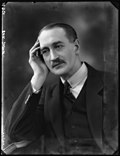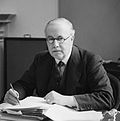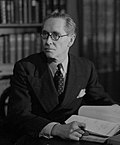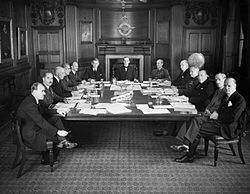Chairman of the Joint War Air Committee, 1916 |
|---|
| Chairman | Term of office | Political party |
|---|
| Took office | Left office | Time in office |
|---|
|  | Edward Stanley
17th Earl of Derby | February
1916 | February
1916 [a] | 7 months and 19 days | Conservative |
Presidents of the Air Board, 1916–1917 |
|---|
| President | Term of office | Political party |
|---|
| Took office | Left office | Time in office |
|---|
|  | George Curzon
1st Earl Curzon of Kedleston | 15 May
1916 | 3 January
1917 | 10 months and 23 days | Conservative |
|  | Weetman Pearson
1st Viscount Cowdray | 3 January
1917 | 26 November
1917 | 10 months and 23 days | Liberal |
Presidents of the Air Council, 1917–1919 |
|---|
| President | Term of office | Political party |
|---|
| Took office | Left office | Time in office |
|---|
|  | Harold Harmsworth
1st Baron Rothermere | 26 November
1917 | 26 April
1918 | 5 months | |
|  | William Weir
1st Baron Weir | 26 April
1918 | 10 January
1919 | 8 months and 15 days | |
|  | J. E. B. Seely
MP for Ilkeston | January
1919 | November
1919 [a] | 9 or 10 months | Conservative |
Secretaries of State for Air, 1919–1964 |
|---|
| Secretary | Term of office | Political party |
|---|
| Took office | Left office | Time in office |
|---|
|  | Winston Churchill [b]
MP for Dundee | 10 January
1919 | 1 April
1921 | 2 years, 2 months and 22 days | Liberal |
|  | Frederick Edward Guest
MP for East Dorset | 1 April
1921 | 19 October
1922 | 1 year, 6 months and 18 days | Liberal |
|  | Sir Samuel Hoare
MP for Chelsea | 31 October
1922 | 22 January
1924 | 1 year, 2 months and 22 days | Conservative |
|  | Christopher Thomson
1st Baron Thomson | 22 January
1924 | 3 November
1924 | 9 months and 12 days | Labour |
|  | Sir Samuel Hoare
MP for Chelsea | 6 November
1924 | 4 June
1929 | 4 years, 6 months and 29 days | Conservative |
|  | Christopher Thomson
1st Baron Thomson | 7 June
1929 | 5 October
1930† | 1 year, 3 months and 28 days | Labour |
|  | William Mackenzie
1st Baron Amulree | 14 October
1930 | 5 November
1931 | 1 year and 22 days | Labour |
|  | Charles Vane-Tempest-Stewart
7th Marquess of Londonderry | 5 November
1931 | 7 June
1935 | 3 years, 7 months and 2 days | Conservative |
|  | Philip Cunliffe-Lister
1st Viscount Swinton | 7 June
1935 | 16 May
1938 | 2 years, 11 months and 9 days | Conservative |
|  | Sir Kingsley Wood
MP for Woolwich West | 16 May
1938 | 3 April
1940 | 1 year, 10 months and 18 days | Conservative |
|  | Sir Samuel Hoare
MP for Chelsea | 3 April
1940 | 11 May
1940 | 1 month and 8 days | Conservative |
|  | Sir Archibald Sinclair
MP for Caithness and Sutherland | 11 May
1940 | 23 May
1945 | 5 years and 12 days | Liberal |
|  | Harold Macmillan
MP for Stockton-on-Tees | 25 May
1945 | 26 July
1945 | 2 months and 1 day | Conservative |
|  | William Wedgwood Benn
1st Viscount Stansgate | 3 August
1945 | 4 October
1946 | 1 year, 2 months and 1 day | Labour |
|  | Philip Noel-Baker
MP for Derby | 4 October
1946 | 7 October
1947 | 1 year and 3 days | Labour |
| | Arthur Henderson
MP for Kingswinford before 1950
MP for Rowley Regis and Tipton after 1950 | 7 October
1947 | 26 October
1951 | 4 years and 19 days | Labour |
|  | William Sidney
6th Baron De L'Isle and Dudley | 31 October
1951 | 20 December
1955 | 4 years, 1 month and 20 days | Conservative |
| | Nigel Birch
MP for West Flintshire | 20 December
1955 | 16 January
1957 | 1 year and 27 days | Conservative |
|  | George Ward
MP for Worcester | 16 January
1957 | 28 October
1960 | 3 years, 9 months and 12 days | Conservative |
|  | Julian Amery
MP for Preston North | 28 October
1960 | 16 July
1962 | 1 year, 8 months and 18 days | Conservative |
|  | Hugh Fraser
MP for Stafford and Stone | 16 July
1962 | 1 April
1964 | 1 year, 8 months and 16 days | Conservative |























